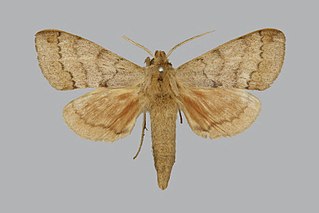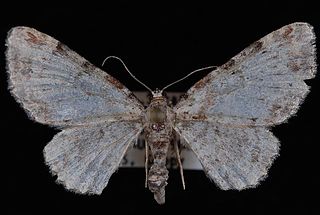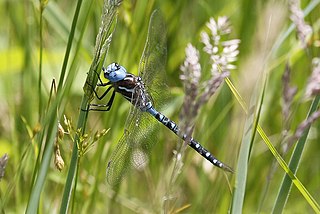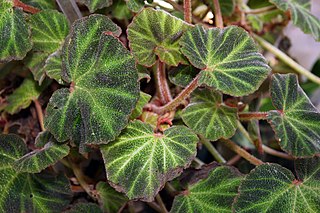
Begonia is a genus of perennial flowering plants in the family Begoniaceae. The genus contains more than 2,000 different plant species. The Begonias are native to moist subtropical and tropical climates. Some species are commonly grown indoors as ornamental houseplants in cooler climates. In cooler climates some species are cultivated outside in summertime for their bright colorful flowers, which have sepals but no petals.

The monarchs comprise a family of over 100 passerine birds which includes shrikebills, paradise flycatchers, and magpie-larks.

Sphaerites is a genus of beetles, the only genus in the family Sphaeritidae, sometimes called the false clown beetles. There are five known species, which are widespread in temperate areas of the Northern Hemisphere, found in forested or upland areas.

The paradise flycatchers (Terpsiphone) are a genus of birds in the family Monarchidae. The genus ranges across Africa and Asia, as well as a number of islands. A few species are migratory, but the majority are resident. The most telling characteristic of the genus is the long tail streamers of the males of many species. In addition to the long tails the males and females are sexually dimorphic and have rufous, black and white plumage.

Mutatá is a municipality in the Colombian department of Antioquia. It is part of the Urabá Antioquia sub-region.

Orsotriaena medus is a butterfly found in south Asia, southeast Asia, and Australia. It is the only species in the genus Orsotriaena, first described by Hans Daniel Johan Wallengren in 1858.

Eleocharis is a virtually cosmopolitan genus of 250 or more species of flowering plants in the sedge family, Cyperaceae. The name is derived from the Greek words ἕλειος (heleios), meaning "marsh dweller," and χάρις (charis), meaning "grace." Members of the genus are known commonly as spikerushes or spikesedges. The genus has a geographically cosmopolitan distribution, with centers of diversity in the Amazon Rainforest and adjacent eastern slopes of the South American Andes, northern Australia, eastern North America, California, Southern Africa, and subtropical Asia. The vast majority of Eleocharis species grow in aquatic or mesic habitats from sea level to higher than 5,000 meters in elevation.

The Malagasy paradise flycatcher is a species of bird in the family Monarchidae. It is found in Comoros, Madagascar, and Mayotte. Its natural habitats are subtropical or tropical dry forest and subtropical or tropical moist lowland forest.
Batillaria mutata is a species of small mudflat saltwater snail, a marine gastropod mollusk in the family Batillariidae, the horn snails.

The Simuliini is a tribe of black flies that contains over 2,000 species, with more than 1,800 in the genus Simulium. There are 19 living genera, and three genera only known from Cretaceous fossils.

Agrotis vetusta, the old man dart, spotted-legged cutworm or muted dart is a moth of the family Noctuidae. The species was first described by Francis Walker in 1865. It is found in North America, from southern Alaska to Nova Scotia, southward into Mexico.

Pseudandriasa is a monotypic moth genus in the family Sphingidae erected by Robert Herbert Carcasson in 1968. Its only species, Pseudandriasa mutata, described by Francis Walker in 1855, is known from KwaZulu-Natal in South Africa.
Kongsrudia mutata is a species of sea snail, a marine gastropod mollusk in the family Pyramidellidae, the pyrams and their allies.

Eupithecia mutata, the spruce cone looper or cloaked pug, is a moth in the family Geometridae. The species was first described by Pearsall in 1908. It is found in the northern Atlantic and New England states in North America. In Canada, the range extends from Nova Scotia to northern Ontario.
The Mutatá Fault is a strike-slip fault in the department of Antioquia in northern Colombia. The fault has a total length of 44.7 kilometres (27.8 mi) and runs along an average northwest to southeast strike of 326.4 ± 11 in the Urabá Basin. The fault is active and produced the 2016 Mutatá earthquake with a moment magnitude of 6.0.

Rhionaeschna mutata, the spatterdock darner, is a species of darner in the dragonfly family Aeshnidae. It is found in North America.
Dictyssa is a genus of tropiduchid planthoppers in the family Tropiduchidae. There are about 17 described species in Dictyssa.
Stegopterna is a genus of black flies. There are about 15 described species in Stegopterna.
Anarta mutata, or the mutant, is a species of cutworm or dart moth in the family Noctuidae.

Begonia solimutata, the sun-changing begonia, is a species of flowering plant in the family Begoniaceae, native to Pará state in northern Brazil. It has gained the Royal Horticultural Society's Award of Garden Merit.













